The Social Practice Group explores what a social practice might be, whilst creating a comfortable space for students to learn, share thoughts and test out ideas together. The Social Practice Group is based at the Royal College of Art and is part of Fuel RCA, the professional development extra-curriculum programme.
Don't wanna be here? Send us removal request.
Text
Social Practice Manifestos after considering a human-rights based approach, with Ali Eisa
In small groups the students developed these notes about ideas for charters or manifestos for a human-rights based approach to working with a participatory arts practice.
Social Practice manifestos: Group 1
How do we avoid getting into difficult situations?
Participants should make the rules!
Create a space that is safe, nourishing
Be able to go when you want to (not being trapped)
Hand the workshop over!
Offering gifts
Our responsibility to create anti-sexist / anti-racist spaces in our workshop
Social Practice manifestos: Group 3
All participants are equal collaborators
Interactions are based on meaningful exchange
Build shared knowledge through participation and not dictation
No-one is expected to perform their labels
Care is enacted in a reciprocal exchange between equals
Social Practice manifestos: Group 4
4.1 Be critical about human-rights as they came from a western point of view
4.2 When working in a project be aware of the limitations of them and work needs to be done on updating them and decolonize them
4.3 More listening
The human rights needs to be participatory! Go back to basics, before we work with people, develop attention to human rights first. Anthropologist: Ariana S. Cota Ethical problems with western countries imposing human rights
Social Practice manifestos: Group 5
Key Principles
Collaboration
Confidentiality
Building trust/ make relationships
Key Actions
That the guidelines will be reviewed by the participants who may want to add or change something
Before starting a project or collaboration, the first step would be becoming familiar with each other as a person.
5 notes
·
View notes
Text
Session 7: Discussion session on a rights-based approach
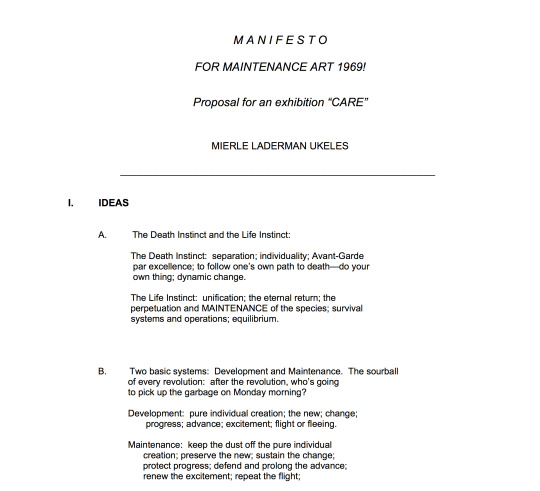
In session 7, the last session for the social practice group in 2021, a small group of 6 students attended. We spent an hour and a half exploring the ideas behind a rights-based practice more deeply.
Session structure:
1. An informal conversation about the social practice group and learning online through the pandemic.
We started the session with an informal conversation with the students where they gave us some feedback about their experiences of the social practice group this year and we asked them about how they had experienced online learning throughout the year, as opposed to being in an off-line physical space. A student asked Hannah ‘what was your original intention?’ with the group. It was interesting to hear from Hannah about how the group grew. Originally it was about being able to allow students to ‘test out ideas together’ and create ‘a space where this could happen’. Abigail (a student who is currently based in China) told us that she missed the 'real life’ teaching, as being able to include touch and other sensory experiences meant that it was more engaging for her.
2. Re-cap: What is a human-rights based approach? After our last session with Ali Eisa, artist and Autograph gallery's learning and participation manager.
Then we jumped into thinking about human-rights based practice, as in the last session we had invited a guest practitioner. Ali Eisa, a socially engaged artist who works on collaborative projects (as the duo Lloyd Corporation) and is Learning & Participation Manager at Autograph.
A useful slide to look at is this webpage, by the Scottish Human Rights Commission http://careaboutrights.scottishhumanrights.com/whatisahumanrightsbasedapproach.html.
And an introduction to Ali Eisa's work on rights visibility and disability here: https://archive.discoversociety.org/2020/08/05/rights-visibility-and-disability-in-cultural-spaces/
In this session we looked with a bit more detail at some of the rights-based practice ideas, starting with the slide from last week that Ali showed us here:
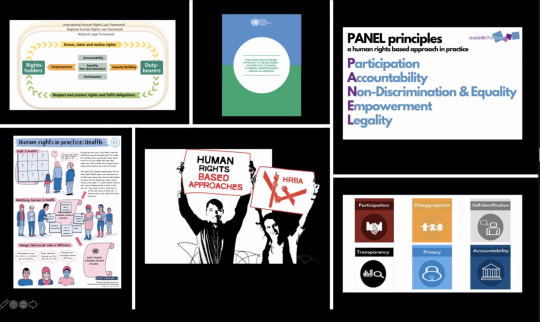
Although a lot of this conversation comes from practice in development, the PANEL principles are useful to take as a frame-work to approach working with others in any area. They stand for:
participation
accountability
non-discrimination and equality
empowerment and
legality
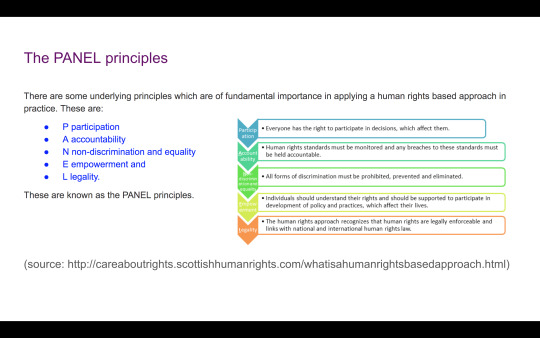
We viewed this video here by the European Youth Forum which is a good introduction to the difference between a 'needs-based approach’ and a rights-based framework.
3. Small group discussions about rights-based verses needs-based approaches.
Then we went into groups of four in zoom break-out rooms, to consider two questions:
What did you think about the human-rights based approach to working with people?
How does it differ from a needs-based approach?
4. Whole group discussion
In the discussion that followed, we discussed these ideas with the whole group. The needs-based approach is one that we are used to, which is considering a person in terms of their supposed 'needs’ and attempting to fulfil these needs, such as funding special-needs based 1 to 1 support in schools for example. The argument in the video by the European Youth Forum suggested that this can create a surface attention to caring for people. When a rights-based approach is used, it can draw our attention to what rights we all have on the planet, and how can we re-organise things so that these can be given attention to. These rights might be things like fundamental basic human rights such as, the right to food, shelter and to be protected from violence and torture, a right to non-discrimination and so on.
But also these rights can be wider, and refer more to the rights around individuals and communities enjoying a level of independence and quality of life, such as, the right to working in a job, the right to having a family, the right to enjoy culture. They can be revealing as they bring our attention to the problems within the system within which we are all in, such as limits on different groups of people being able to exercise their rights This approach makes it clear that everyone should have these rights, and when rights are taken away it is very serious and their are re-percussions. It can also highlight our involvement as well as our responsibility to support others to have access to knowing and exercising their rights.
One student said that it was a 'fundamental shift in thought’.
5. Reading charters and manifestos, the texts sent to us by Ali Eisa.
In small groups we selected from the texts that Ali had sent us and read through some parts of them for around ten minutes as we discussed some questions:
What would it look like to use these ideas as an approach to working with people with a creative social practice?
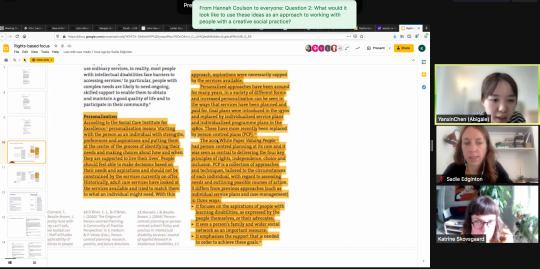
Here are the texts if you wish to read them:
The Universal Declaration of Human Rights (1948) https://www.ohchr.org/Documents/Publications/ABCannexesen.pdf
Project Art Works (Hastings) Anthology https://projectartworks.org/product/anthology-1997-2012/
M A N I F E S T O FOR MAINTENANCE ART 1969! Proposal for an exhibition “CARE” by MIERLE LADERMAN UKELES https://www.artpractical.com/uploads/docs/5.4-Ukeles_MANIFESTO.pdf
If anyone if looking for further reading about this subject, Ali suggested the text: Beyond 'rights-based approaches'? Employing a process and outcomes framework: https://www.tandfonline.com/doi/full/10.1080/13642987.2019.1607210
6. Writing activity: ways that these ideas could be an every-day practice
Lastly we spent a few minutes thinking to ourselves about ways in which some of these ideas could be taken on board to inform day to day arts practice. Whether this would be about thinking through ways of working with institutions, people, communities and other artists, such as deciding work and labour contracts, approaches, models or methods.
0 notes
Text
Session 6. A rights-based approach to working with people with Ali Esa
Tuesday 11th May 2021
We had a brilliant workshop with artist and educator Ali Eisa. Ali has been working as both a socially engaged artist, developing independent and collaborative projects as Lloyd Corporation, whilst working as the Learning & Participation Manager at Autograph. Autograph is a gallery in Shoreditch, London, which explores identity, representation and human rights through photography. Over the last few years Ali has been working with and thinking through what constitutes a Rights Based Approach to art and participation. Through projects working with marginalised people including refugees and asylum seekers, young people from BPOC and disadvantaged backgrounds and Windrush elders. These projects have provided much reflection on how rights can be placed at the centre of arts participation and what difference this makes to the politics and ethics of our work as social practitioners.
Session Introduction:
‘The session will reflect on what a Rights Focused Approach might mean and look like in practice. Through examples from Ali’s practice and group discussion we will consider key questions such as: What are the power dynamics in the relationships between artists and participants? Why do we work with the most marginalised people and what exchanges actually occur in these projects? Does collaboration mean equality and what steps can we take to ensure people have agency in participatory engagements? Taking our discussions in the session we will work on producing a ‘manifesto’ or ‘charter’, as a way of bringing our collective beliefs on the politics of social practice together into a series of statements or provocations we can all take with us into shaping future projects.’
**
Before the workshop Ali sent us some documents and links to look through:
The Universal Declaration of Human Rights (1948) https://www.ohchr.org/Documents/Publications/ABCannexesen.pdf
Project Art Works (Hastings) Anthology https://projectartworks.org/product/anthology-1997-2012/
M A N I F E S T O FOR MAINTENANCE ART 1969! Proposal for an exhibition “CARE” by MIERLE LADERMAN UKELES https://www.artpractical.com/uploads/docs/5.4-Ukeles_MANIFESTO.pdf
https://archive.discoversociety.org/2020/08/05/rights-visibility-and-disability-in-cultural-spaces/
https://autograph.org.uk/
https://projectartworks.org/the-programme/film/
1. Ali started the workshop with an Ice breaker: Word Association
I will say a list of words and you have to write down what you associate it with (the first thing that comes into your head) and hold it up for the camera
Words: Human, Rights, Race, Representation, Care, Future, Global, Need, Quality, Labour, Identity, Voice
We wrote our immediate response on paper and held them up to the screen, and Ali read people’s out.
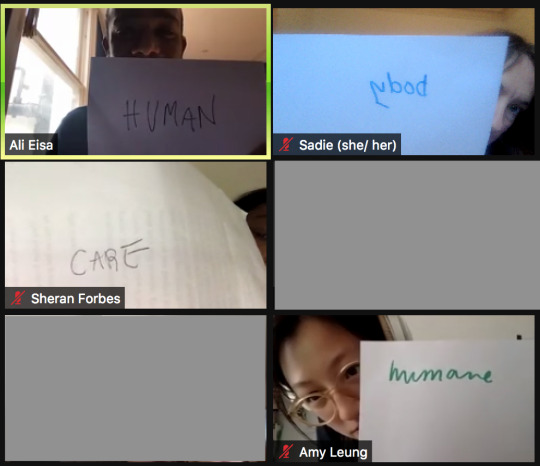
2. Ali then did a presentation of projects and ideas around a Rights Based Approach.
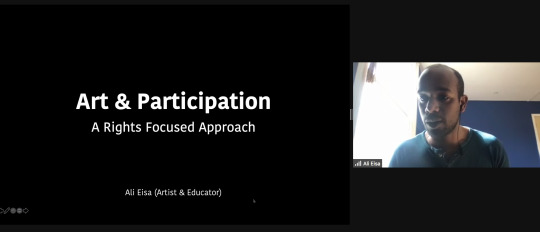
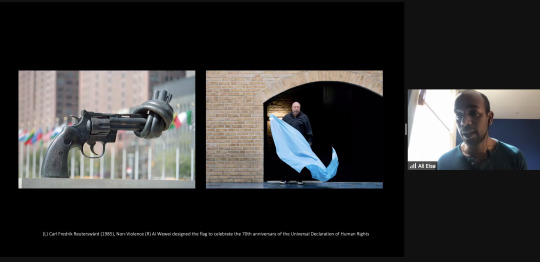
When showing this image, Ali made it clear that he was not talking about contemporary art about human rights, such as shown in the above image, but focusing on participatory arts practice which works with a human-rights based approach to working with people. The image on the left is Carl Fredrik Reutersward (1985) Non-Violence, and on the right, Ai Weiwei designed the flag to celebrate the 70th anniversary of the Universal Declaration of Human Rights.

These images show the SEND workshops at Autograph in 2019, which Ali has been organising (on the left) and the Canvas(s) project with young people from a refugee background in 2017 (on the right).

This slide shows the PANEL principles often used in development work with a rights-based approach.
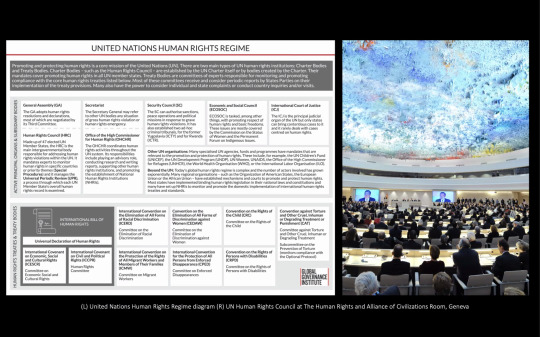
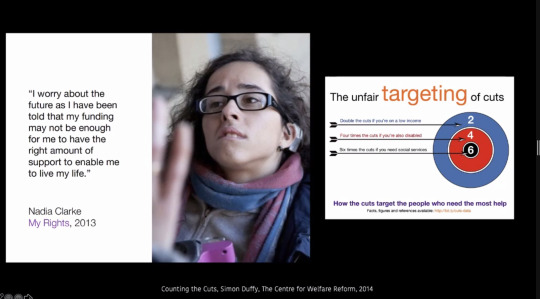
Image: Counting the cuts, Simon Duffy, The centre for welfare reform, 2014
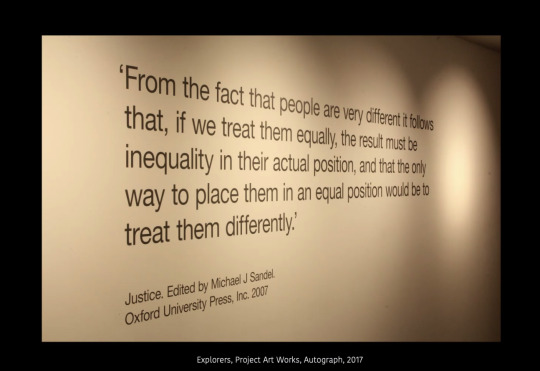
Image: Explorers, Project Art Works, Autograph 2017. Ali talked us through the collaborative project with Project Art Works, an arts organisation from Hastings, and highlighted some of their techniques of working with adults.
3. Discussion. There was a lot of interest in these ideas which came out through a lively discussion with the students and other workshop participants afterwards. It was clear that we needed to spend some time pulling apart these themes some more.
4. Group work: thinking about human-rights manifestos. We went into small groups and discussed how we would create our own charter or manifesto, and what we thought might be important to put into this. We wrote out some manifesto ideas from our discussions about a rights-based practice and we shared back again with the large group, here are the ideas from the groups below.
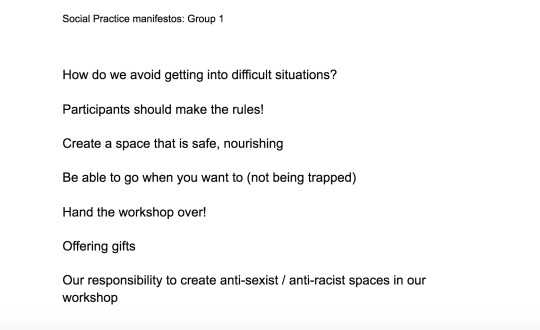
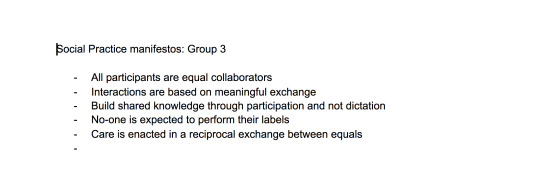


Thanks for a thoughtful session Ali, it really got us thinking...
0 notes
Text
Session 5: Developing Do’s and Don’ts for the online learning space
These points were written by students, graduates and visiting artists in the RCA Social Practice Group session in March 2021.
We were responding to Raju Rage’s ‘Do’s and Don'ts on Socially Engaged Practice’, which can be seen in the zine called Chump Change by Aislinn Evans here and is free to download, please read it.
The below do’s and don'ts were written by the group’s members in a workshop. They do not represent any particular persons views, or the RCA or the Social Practice Groups views, they are an unedited collection of do’s and don'ts written by students, graduates, artists, educators and facilitators.
We decided to focus our do’s and don'ts on the online workshop situation, as this was the space that we have been meeting in over the past year. Where we have been meeting artists and practitioners and experiencing and discussing social art practice.
See the do’s and don’ts clearly here
////
Do’s and Don'ts for the online learning space, by the Social Practice Group, March 2021
Do/ Don’t
Do build in time so that everyone may speak or contribute
Don’t rush. Rehearse what you can, practice, and if you really don’t have enough time, leave something out
Do balance openness with structure, freedom with guidance
Don’t have strict expectations of the results or outcomes, participatory social art is about embracing the unknown
Do consider how dynamics change on Zoom and take it as an opportunity to be creative with process
Don’t proceed just as you would with a physical meeting, assuming Zoom can operate in the same way
Do consider ways of inviting people to speak that will facilitate without pressure
Don’t assume that if someone doesn't speak it’s because they don’t want to
Do give importance to what happens before the event e.g. the form of the invitation, setting the scene etc
Don’t view the Zoom event as separate from what happens before and after.
Do find ways to bring the body onto the Zoom experience - e.g. physical movement, food, making
Don’t plan sessions based on people looking at the screen the whole time
Do create opportunities for one to one or small group conversation and/or chance encounters (e.g. people can now move themselves around break-out rooms)
DO slow down. Take the time to really take time. Give space around the tasks for them to develop and grow.
DON’T zip around quickly from task to task without giving the important things breathing space. If people need to just ‘talk’ it out, they might really need that. Time online goes fast but it can also be expansive. One question to think about for ten minutes can generate a lot.
DO Breathe. Being social right now is unusual. Give everyone a break every 30/60 mins. Create spaces in the workshop for time away from the screen, writing, thinking, and reconnecting with your body in the room.
DON’T plan very long sessions, unless there are multiple breaks for people to go to the toilet, get a drink, get air. If it is over 2 hours, you need longer breaks.
DO welcome people in and connect to people when they arrive. Hear everyone’s voice. Whilst at the same time DON’T make everyone speak or be viewed, or interact if they do not feel comfortable.
DO create small spaces for people to reflect with one or two others.
DON’T put people on the spot in the big group
Do be patient, with yourself and others.
Don’t pressure yourself to be constantly present online, replying to emails, attending events etc.
Do take time (6mins) before or after a zoom call to reset, prepare, transition, decompress, move, check in with your body, before the next task.
Don’t let your day be dictated by the constant stream of online tasks / interactions / screen time.
Do uphold a standard of practice and engagement.
Don’t blame zoom for bad practice (a bad workshop or an offensive lecture). Speak up and seek to make connections to change things.
Do open the software and do work
Don’t procrastinate
Do engage in the Zoom call or Panopto
Don’t think they are regular Youtube videos, convince yourself to set a goal for your future or insights.
Do take care of your room, your food and your study.
Don’t look upon your other people to help you out. Or overthink about things.
0 notes
Text
Raju Rage had me at ‘Recipes for resistance’ by Dora Lam
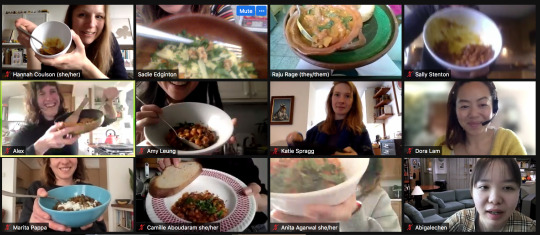
Raju Rage had me at ‘Recipes for resistance’
Shortly after introducing their practice, across the zoom grid of apertures into a dozen kitchens, everyone was sharing (and eating) their own masala beans. Raju had shared a recipe for us to cook these beans before the session, and it was the perfect starter for what was going to be a thought provoking session on the deeper meanings behind food and recipes, the politics of food, and food as a conduit for conversation.
Given the often inadequate documentation and retelling of socially engaged art work, participation is really the only way to experience it. My practice has recently taken a leap towards social engaged art so I jumped at the opportunity to connect with others who are practicing or interested in the field. Having Raju Rage lead the workshop was doubly valuable and validating as I have recently been exploring diaspora, migration and cultural heritage through food in the East & South East Asian community starting with my family (our social piece “Making Clay Dumplings” recently featured on Grayson Perry’s Art Club - the food-themed episode!)
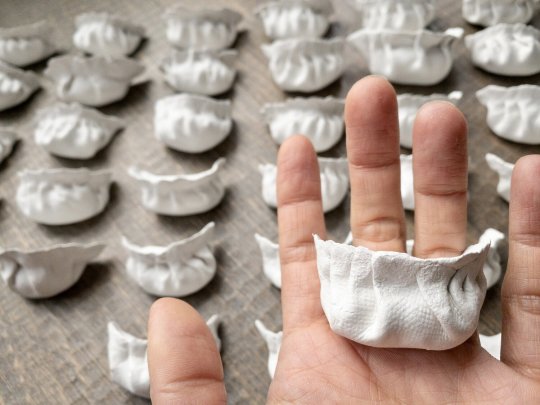
Raju spoke at depth around the idea of resilience in recipes - how they are adapted and adopted. Importantly, they affirmed that the politics of food is important - explaining that not everyone has access to politics or wants to access it, and art and food gives way to having conversations in a safe space within a familiar activity - through cooking and eating. In smaller groups, we took a deep look at a chosen piece from Raju’s group publication ‘Recipes for resistance’. The piece was thought provoking, and the jamboard an engaging way for us from different geographies and perspectives to collectively map out “what is outside a recipe?” Conspiracies, chaos and sounds, we decided.
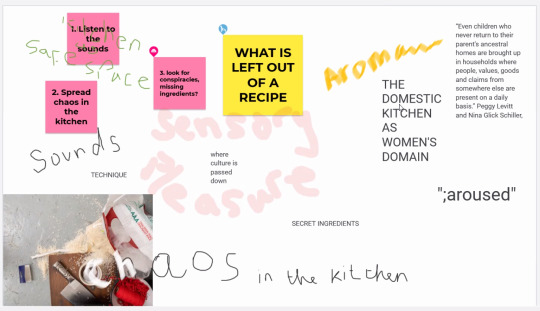
Given the restrictive times we currently live in, the Social Practice Group sessions provide a safe and valuable space for practitioners to experience and experiment with social practice directly. I am currently in research mode for a residency which aims to preserve and document the cultural heritage through food practices in London Chinatown. No doubt these sessions will continue to be nourishing and educational. This one just happened to be delicious as well.
By Dora Lam
Instagram: @dorathedrawer
Dora Lam is currently studying on the Graduate Diploma Art & Design at The Royal College of Art and will study on the Masters in Contemporary Art Practice, on the Public Sphere pathway in 2021.
0 notes
Photo
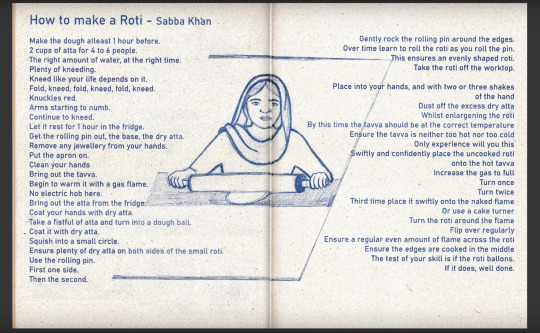
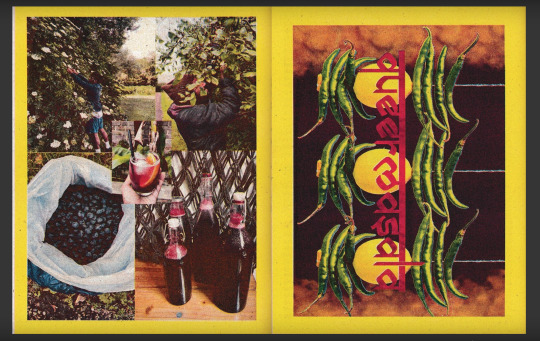
Recipes for Resistance with Raju Rage
Tuesday March 16th 2021 4pm – 6pm (UK time)
‘Just the other day I was reading that resilience is an ecology more than it is an individual trait or possession. If so, dreaming together can weave the context for our healing. That is: a container, an atmosphere, a potentiality. Not transcendence. In fact, I’m not sure how much we’re breaking free of personal/collective trauma as much as we’re brewing adaptogens, recipes for resistance, a kiss and a fist.’ Almah LaVon (2015)
The second artist-led workshop with the Social Practice Group is an introduction to the practice of Raju Rage, an artist, curator and educator. Raju has a theirstory in activism, self and collective organised queer/ transgender/ people of colour movements. We will be cooking (before the workshop) and eating together to experience part of Raju’s project ‘recipes for resistance’. The project centres South Asian voices, from South Asia and the diaspora, in an ‘attempt to connect them better and platform issues of ethnicity, religion, caste and gender’. Encompassing a collaborative publication, and an exhibition, ‘Recipes for Resistance’ explores the politics of food and to migration, belonging, memory, culture, coloniality, gender, resilience, adaptability and resistance and how it functions as both a metaphor for and testimony to survival. This session will reflect on recipes and adaptability and what this means in our lives.
Please note, this session has a pre-session activity and instructions, see below:
For this session, you are invited to cook something beforehand as we will be eating together whilst on the zoom call.
Raju would like to invite you to use the masala beans recipe by Tanya Gohil at the end of this article to prepare a version yourself to eat during the workshop. You are encouraged to add or change ingredients in the recipe according to what makes most sense to you in terms of culture, convenience, experimentation. Bring this with you to the beginning of the session.
Pre- session Instruction: please situate yourself in your kitchen (if it is possible!) for the duration of this workshop.
The recipe is online here at the end of this article: https://62gladstonestreet.co.uk/2020/09/02/recipes-for-resistance-exploring-south-asian-identities-through-the-prism-of-food/
/////
Raju Rage is proactive about using art, education and activism to forge creative survival. Based in London and working beyond, they explore the spaces and relationships between dis/connected bodies, theory and practice, text and the body and aesthetics and the political substance. Their current interests are around sustainability, economies, care, and resistance. They are a member of Collective Creativity arts collective, A People’s Art Collective, Another Roadmap and a creative educator and independent scholar with an interest in radical pedagogy. Recent projects include Under/Valued Energetic Economy at Banner Repeater and the Politics of intimacy in practice LADA DIY workshop and exhibition Recipes for Resistance at Ort Gallery, Birmingham. http://www.rajurage.com/
////////
Other project Links:
Download this free PDF zine, p10 ’ A guide to socially engaged practice’ do’s and donts by Raju Rage https://www.thisisunbound.co.uk/products/chump-change
Recipes for Resistance Publication https://issuu.com/raju_rage/docs/compilation_final
1 note
·
View note
Text
Physicality of materials... reference list
Reading list and links from the ‘Working with people and materials across the screen’ with Amy Leung and Katie Spragg (9th February 2021)
Peter Dormer Lecture: Deirdre Figueiredo (Director of Craftspace) https://www.rca.ac.uk/news-and-events/events/peter-dormer-lecture-2021-deirdre-figueiredo-mbe/
Donna Haraway, Staying with the trouble – sympoiesis “a simple word; it means “making-with.” Nothing makes itself; nothing is really autopoietic or self-organizing … Sympoiesis is a word proper to complex, dynamic, responsive, situated, historical systems. It is a word for worlding-with, in company. Sympoiesis enfolds autopoiesis and generatively unfurls and extends it.”
THOMPSON, Tonika Sealy and HARNEY, Stefano. Ground provisions. (2018). Afterall: A Journal of Art, Context and Enquiry. 120-125. Research Collection Lee Kong Chian School Of Business. “Reading together, silently or aloud, belongs with dancing together, cooking together, drinking together, watching movies together, building and cultivating together – and making together. Rather than understanding making as the result of successful social reproduction, we practise it as a temporary emanation, a stepping out without stepping away, where art remains part of the life-giving arts, not a superior comment on them or achievement based on their repro- ductive support. Support is our thing, as Shannon Jackson might say. Support is as Fania and Angela Davis say, the process of creating the society we want right now.”
Diana Coole and Samantha Frost: Introducing the New Materialisms, Introduction: Towards a New Ontology: Matter, Agency and Posthumanism For materiality is always something more than ‘‘mere’’ matter: an excess, force, vitality, relationality, or difference that renders matter active, self-creative, productive, unpredictable. In sum, new materialists are rediscovering a materiality that materializes, evincing immanent modes of self-transformation that compel us to think of causation in far more complex terms; to recognize that phenomena are caught in a multitude of interlocking systems and forces and to consider anew the location and nature of capacities for agency.
One could conclude, accordingly, that ‘‘matter becomes’’ rather than that ‘‘matter is.’’ It is in these choreographies of becoming that we find cosmic forces assembling and disintegrating to forge more or less enduring patterns that may provisionally exhibit internally coherent, efficacious organization: objects forming and emerging within relational fields, bodies composing their natural environment in ways that are corporeally meaningful for them, and subjectivities being constituted as open series of capacities or potencies that emerge hazardously and ambiguously within a multitude of organic and social processes. In this monolithic but multiply tiered ontology, there is no definitive break between sentient and nonsentient entities or between material and spiritual phenomena.
Tara Page: Teaching and Learning with Matter Bodies and things are not as separate as we were once taught, and their intra-relationship is vital to how we come to know ourselves as humans and interact with our environments. The body is pivotal to new materialism, it is a complex intra-action (Barad 2007) of the social and affective, where embodiment is a process of encounters, intra-actions with other bodies (Springgay 2008). Thinking about matter matters—if bodies and things are produced together, intertwined, then ‘things’ and how they act on bodies are co-constitutive of our embodied subjectivity1.
3. Material Pedagogy As I stated previously, through bodies with matter, we are always making, performing and learning. So I put forward that we learn through and with embodied histories and pedagogies but also with matter. It is the intra-actions, the between of bodies and matter that is pedagogic, as ceramic artist De Waal (2011) explains:
Centering the clay, bringing the small ball into perfect reactivity for throwing, involved a ripple of different movements from hand and wrist, an inclination in the head and neck a slight tautening in the shoulders. It was … learning that I could not articulate. (p. 1)
This creative act of learning, of body with matter (clay, wheel, water), is what van der Tuin (2014) asserts is an example of Barad (2003) practices of knowing in being (p. 262).
Hillevi Lenz Taguchi, Going Beyond the Theory/Practice Divide in Early Childhood Education: Introducing an Intra-Active Pedagogy (2010) ‘The child’s hand is grabbing a handful of sand and then slowly letting it go above the bucket. The light wind carries the grains, spreading them out across the surface of the sandbox … the glittering flow of sand, swirling in the wind and catching rays of sun: the grains spreading, dancing, and gently ascending towards the sandpit surface to become part of the greater whole.’ Juliette Kristensen RCA Lecture SLIME: That Hinterland Substance; This Material of the Moment’ RCA: Urgency of the Arts Lecture series. Available at: http://research.gold.ac.uk/id/eprint/27506/
Tim Ingold, On Weaving a Basket
Jane Bennett, Vibrant Matter
Jaroslav Andel , Back to the Sandbox: Art and Radical Pedagogy
3 notes
·
View notes
Text
Session 2: Images from ‘Working with people and materials across a screen’
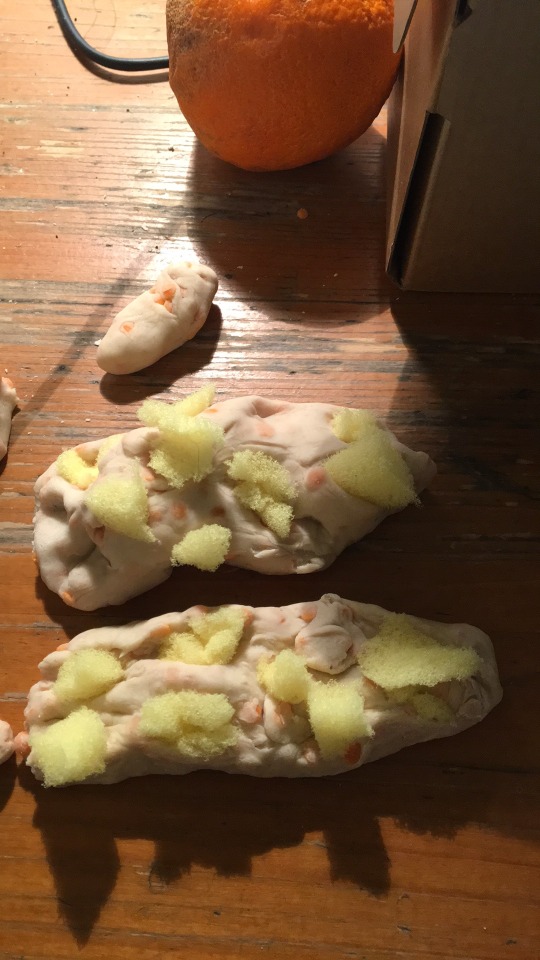
Image credit: Sadie Edginton
Session 2: February 9th 2021
With Amy Leung https://amyleung.hotglue.me/
and Katie Spragg http://www.katiespragg.com/
Amy Leung leads her workshop activity below, with the instructions to bring ingredients along to the session.
We started the session with a check-in, stretching a bit and filling the screens with our hands and fingers.
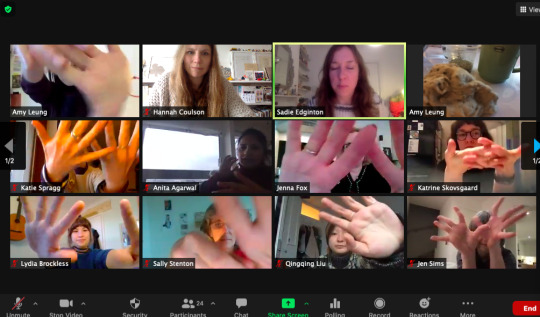
Materials to collect beforehand: a cup of flour (plain / self raising / gluten free – whatever you might have) half a cup of water handful of loose grains (ie. rice, couscous, oats, lentils, dried beans, herbs …) a bowl
Optional: tablespoon of oil, half a cup of salt
Here’s the view from the dough cam:
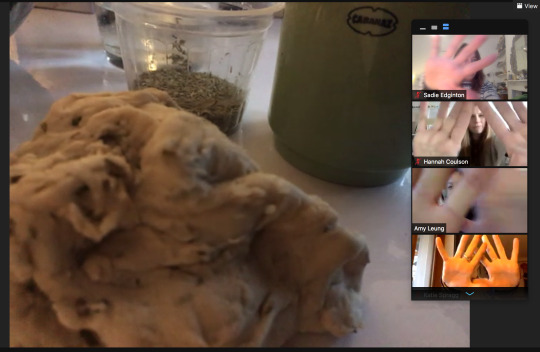
Amy added lavender. People started experimenting with adding in different textured food stuffs, such as coffee, spices, coloured lentils. We became absorbed in mixing the materials.
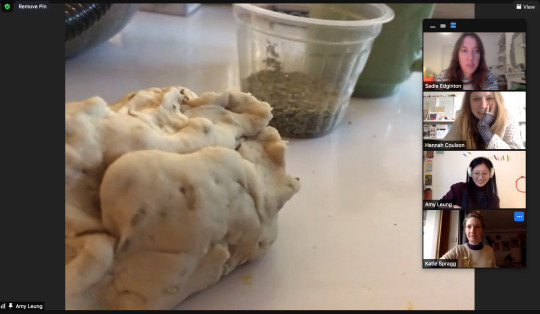


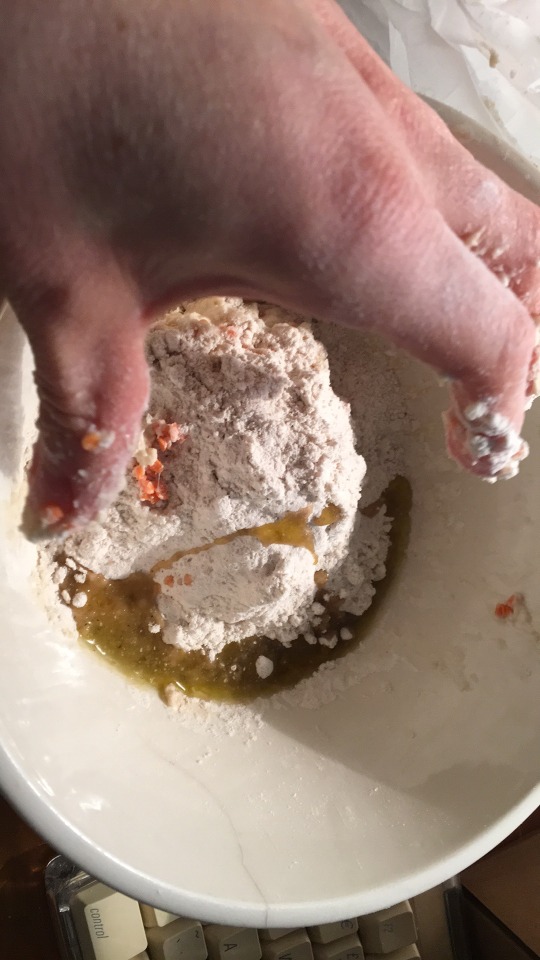
Amy introduced the idea of an EY dough gym, connection to fine motor skills, what other learning might playing with this interaction with material enable?
https://www.youtube.com/watch?v=i-IfzeG1aC4
We tried out a dough gym exercise!
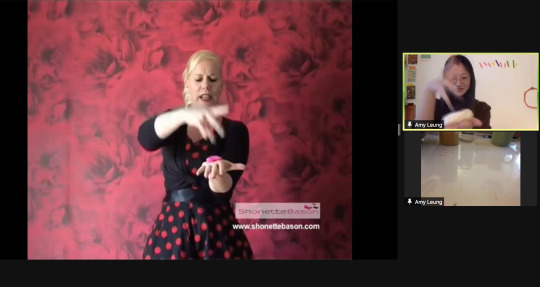
In small groups we played with squidging out the dough into different shapes, and made up a sequence of actions.
Instructions: Document sequence via screenshots / video / words etc - the conundrum of social practice and documentation

How many fingers can your dough hold?

Katie showed images of her incredible ceramic practice and inspirational images.

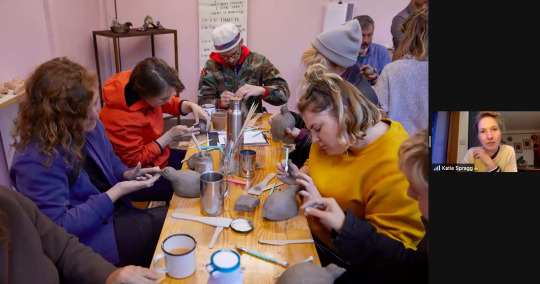
Holding space to make together Katie asked us to chose a material in the home, that we could work with...
‘Find something round(ish) that has the possibility to be manipulated with your hands - plasticine? pastry? an orange? clay? fabric? toilet roll? small cushion?
(+ a tea towel)
Unmute your mics, close your eyes
knock into a ball, push your thumb half way in, pinch and turn, pinch and turn…
open our eyes and reveal/share our pots in all their messy glory
Repeat with dough
Experiment with other (ceramics derived) processes and actions:
coiling, rolling tiny components, pinching, slabbing, constructing, weaving?’
While making, questions to ask each other:
What kinds of ‘making’ and ‘materials’ do you use in your practice?
Do you have any ideas for ‘making together’?
Do you have ideas for engaging online, away from the screen?
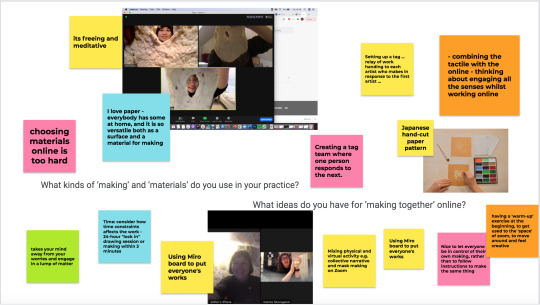
The group answered questions about making above!!
0 notes
Text
Working with people and materials across a screen
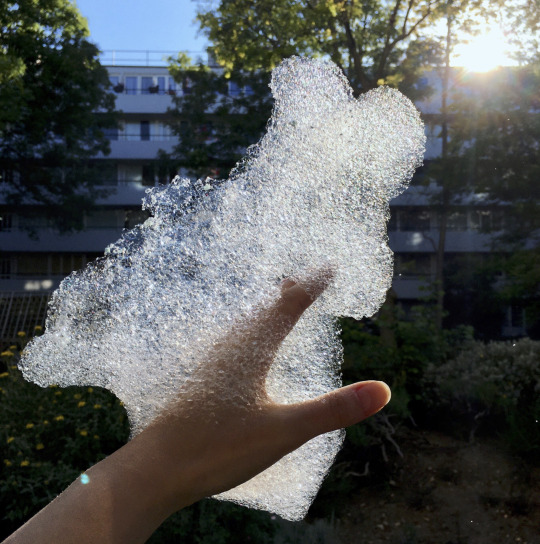
Image Credit: Amy Leung, from MakeShiftStudio at Towner, Eastbourne
Social Practice Group Session 2: Working with people and materials across a screen
With artists and educators Amy Leung and Katie Spragg
Organised by Sadie Edginton
Tuesday February 9th 2021, 4 – 6pm
The first workshop with the Social Practice Group will explore the importance of working with 'hand-based' material processes, with other people. The two artists we've invited have a participatory aspect to their practice - working in education settings and with community groups. They have adapted to the current pandemic situation by devising interesting approaches to working with others, enabling them to continue to explore the benefits of making with hands-on materials. Whether tactile, immersive, relaxing or sensory, we will test out some workshop techniques together! Both artists have collected texts and references for us on materials and making, from 'slime', to histories of weaving with others, making connections around hand-making processes.
Please note:
For this session, you will need to come prepared with some materials, as we will be mixing dough together whilst on the zoom call. Make sure you have a space set-up in front of your screen, and have your ingredients listed below ready before we start at 4pm. Perhaps have a plastic bag at hand to protect your keyboard. We will be experimenting with recording the session, and would like to film some of the collective making processes, but we will alert you beforehand.
Materials to collect beforehand:
a cup of flour (plain / self raising / gluten free – whatever you might have)
half a cup of water
handful of loose grains (ie. rice, couscous, oats, lentils, dried beans, herbs ...)
a bowl
Optional: tablespoon of oil, half a cup of salt
Amy Leung is a London based artist and art educator working across sculpture, drawing and workshops to explore the articulation and communication of joy. She is interested in the intersections in which community, craft, objects and cultural identity meet. Amy is currently studying on the MA in Art and Design in Education at the Institute of Education, UCL and is also part of ‘Surface Matters’. She has delivered projects with Towner Eastbourne, South London Gallery, MK Gallery and Firstsite and is currently Artist in Residence at Harris Girls Academy, East Dulwich. https://amyleung.hotglue.me/
Katie Spragg is an artist and educator, graduating from the MA Ceramics & Glass at the RCA in 2016. Katie's practice combines clay with a range of processes including animation and installation. As well as teaching at the RCA on the MA Ceramics & Glass and the Teaching Fellowship Scheme, Katie is a founding member of Collective Matter, an outreach group who pioneer collaborative practice through clay. She has developed a Clay for Dementia programme with the Garden Museum and has work held in collections and has created commissions for international institutions including the V&A Museum, British Ceramics Biennale and Sotheby’s. https://www.katiespragg.com/
Further reading around the topic: For every session we will be asking practitioners to add to our collection of resources around this topic. These will be added to the Social Practice Group blog, please see the links and texts at the end of the email, for further interest in this topic and if you have any recommendations feel free to send them over.
Suggested reading, quotes and links on this topic
Peter Dormer Lecture: Deirdre Figueiredo (Director of Craftspace)
https://www.rca.ac.uk/news-and-events/events/peter-dormer-lecture-2021-deirdre-figueiredo-mbe/
Donna Haraway, Staying with the trouble - sympoiesis
“a simple word; it means “making-with.” Nothing makes itself; nothing is really autopoietic or self-organizing … Sympoiesis is a word proper to complex, dynamic, responsive, situated, historical systems. It is a word for worlding-with, in company. Sympoiesis enfolds autopoiesis and generatively unfurls and extends it.”
THOMPSON, Tonika Sealy and HARNEY, Stefano. Ground provisions. (2018). Afterall: A Journal of Art, Context and Enquiry. 120-125. Research Collection Lee Kong Chian School Of Business.
“Reading together, silently or aloud, belongs with dancing together, cooking together, drinking together, watching movies together, building and cultivating together – and making together. Rather than understanding making as the result of successful social reproduction, we practise it as a temporary emanation, a stepping out without stepping away, where art remains part of the life-giving arts, not a superior comment on them or achievement based on their repro- ductive support. Support is our thing, as Shannon Jackson might say. Support is as Fania and Angela Davis say, the process of creating the society we want right now.”
Diana Coole and Samantha Frost: Introducing the New Materialisms
Introduction: Towards a New Ontology: Matter, Agency and Posthumanism
For materiality is always something more than ‘‘mere’’ matter: an excess, force, vitality, relationality, or difference that renders matter active, self-creative, productive, unpredictable. In sum, new materialists are rediscovering a materiality that materializes, evincing immanent modes of self-transformation that compel us to think of causation in far more complex terms; to recognize that phenomena are caught in a multitude of interlocking systems and forces and to consider anew the location and nature of capacities for agency.
One could conclude, accordingly, that ‘‘matter becomes’’ rather than that ‘‘matter is.’’ It is in these choreographies of becoming that we find cosmic forces assembling and disintegrating to forge more or less enduring patterns that may provisionally exhibit internally coherent, efficacious organization: objects forming and emerging within relational fields, bodies composing their natural environment in ways that are corporeally meaningful for them, and subjectivities being constituted as open series of capacities or potencies that emerge hazardously and ambiguously within a multitude of organic and social processes. In this monolithic but multiply tiered ontology, there is no definitive break between sentient and nonsentient entities or between material and spiritual phenomena.
Tara Page: Teaching and Learning with Matter
Bodies and things are not as separate as we were once taught, and their intra-relationship is vital to how we come to know ourselves as humans and interact with our environments. The body is pivotal to new materialism, it is a complex intra-action (Barad 2007) of the social and affective, where embodiment is a process of encounters, intra-actions with other bodies (Springgay 2008). Thinking about matter matters—if bodies and things are produced together, intertwined, then ‘things’ and how they act on bodies are co-constitutive of our embodied subjectivity1.
3. Material Pedagogy
As I stated previously, through bodies with matter, we are always making, performing and learning. So I put forward that we learn through and with embodied histories and pedagogies but also with matter. It is the intra-actions, the between of bodies and matter that is pedagogic, as ceramic artist De Waal (2011) explains:
Centering the clay, bringing the small ball into perfect reactivity for throwing, involved a ripple of different movements from hand and wrist, an inclination in the head and neck a slight tautening in the shoulders. It was . . . learning that I could not articulate. (p. 1)
This creative act of learning, of body with matter (clay, wheel, water), is what van der Tuin (2014) asserts is an example of Barad (2003) practices of knowing in being (p. 262).
Hillevi Lenz Taguchi (2010) Going Beyond the Theory/Practice Divide in Early Childhood Education: Introducing an Intra-Active Pedagogy.
'The child's hand is grabbing a handful of sand and then slowly letting it go above the bucket. The light wind carries the grains, spreading them out across the surface of the sandbox ... the glittering flow of sand, swirling in the wind and catching rays of sun: the grains spreading, dancing, and gently ascending towards the sandpit surface to become part of the greater whole.'
Juliette Kristensen RCA Lecture
'SLIME: That Hinterland Substance; This Material of the Moment' RCA: Urgency of the Arts Lecture series. Available at: http://research.gold.ac.uk/id/eprint/27506/
Hillevi Lenz Taguchi (2010) Going Beyond the Theory/Practice Divide in Early Childhood Education: Introducing an Intra-Active Pedagogy.
'The child's hand is grabbing a handful of sand and then slowly letting it go above the bucket. The light wind carries the grains, spreading them out across the surface of the sandbox ... the glittering flow of sand, swirling in the wind and catching rays of sun: the grains spreading, dancing, and gently ascending towards the sandpit surface to become part of the greater whole.'
Juliette Kristensen RCA Lecture
'SLIME: That Hinterland Substance; This Material of the Moment' RCA: Urgency of the Arts Lecture series. Available at: http://research.gold.ac.uk/id/eprint/27506/
0 notes
Text
1st Introductory Session, January 26th 2021
We met just over 40 students at the first session for the Social Practice Group last week. It was inspiring to join some conversations and hear what experience and ideas the students have about this area of practice.
We went into small breakout rooms to consider the following questions:
1) What comes under the term social practice (for you)?
2) Are there any other terms that relate to this, that you want to bring into the conversation? What do you think about these terms?
Ideas and important points ended up on the jam board we created here:
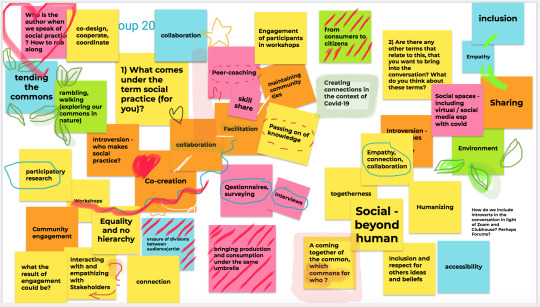
From all of the students interests we identified a list of topics which we then used to name break-out groups. The students could choose which group to go into and start a conversation.
Care / Health / Ageing Politics & protest Connecting during covid-19 / digital & online working Collaboration / co-design Ethics of social practice Methods of working with others Feminism & social practice Documenting social practice Relating social practice to the art world (or not) Public art / architecture / social systems / urban planning Queer / LBGT social practice Working with children / families Environment/ ecosystems/ environmental activism
In the groups we asked people to...
Introduce yourself to your group (pronoun, practice and RCA course)
What is your specific interest in social practice related to this Breakout group?
How does it relate to the direction of your practice? What does it mean to you?
Here’s a few notes from Sadie’s sketchbook:
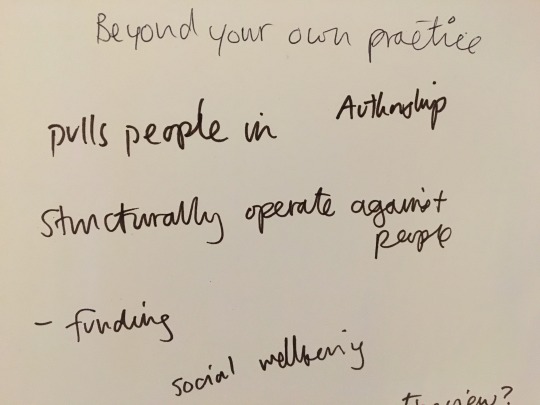
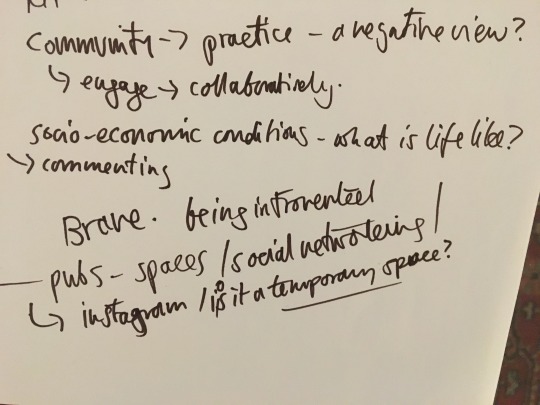
1 note
·
View note
Text
Sally Stenton writes about continuing a collaborative research and testing process
Sally Stenton, Royal College of Art MRes (master of research) graduate, recalls her process of walking and mapping through lockdown and how things continued for her after attending the Social Practice Group in 2020.
‘The Social Practice Group has been a great ally in exploring how it might be possible to engage with others online, providing opportunities to test out ideas and discuss the challenges.’
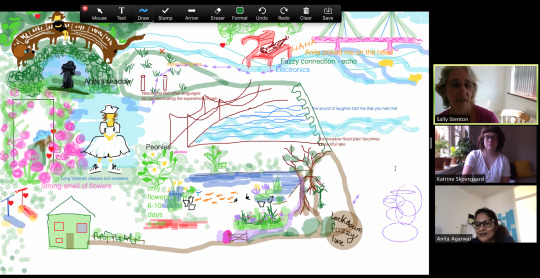
Image: Sally, Anita and Katrina collaborate on zoom weaving their walks together digitally, using the collaborative annotate tool.
‘Just before the initial lockdown Kat and I walked together in Battersea Park. We talked about walking and writing, pain and proximity, and straight after went to my studio to map out our walk, adding drawings and words to large sheets of paper on the floor and exploring this indoor space with our bodies. It was a powerful way of connecting back to the experience of the walk and has had a lasting impact on both our areas of research. When all teaching had moved online the social practice group reconnected us and fellow collaborator Anita and we walked together connected by voice. Kat and Anita walked towards each other and converged in Battersea Park, whilst I walked 60 miles away near Cambridge. Afterwards we wove our walks together on a digital whiteboard in a vague imitation of the physical activity Kat and I had performed a few months before.’
‘I completed my research thesis for the MRes in October 2020. The pandemic hit half way through the course I was faced with re-imagining a participatory walking practice. I developed a range of strategies for walking with others at a distance, sometimes with the aid of technology and more often now without. The Social Practice Group has been a great ally in exploring how it might be possible to engage with others online, providing opportunities to test out ideas and discuss the challenges.’
‘Since finishing the MRes I have set up an international online residency (A Glass Envelope) and have created connections between people through walking. 'Walking without edges’ is a project that involves people walking at the same time each week in different places in response to poetic prompts that reframe their familiar walks. Our experiences are then collaged together by one of the walkers. By the end of October we hope to have 52 collages that can be printed and disseminated as further invitations to walk. My interest is in the blurring of human edges and I am currently distributing re-sendable postcards to activate crazy walks with our non-human compatriots.’
www.sallystenton.com
0 notes
Text
Student Experiments
Social Practice Session: June 16th 2020
In June we held a Social Practice Group session after the series of workshops had finished. We were keen to create a space for students to test out their own ideas, after experiencing and discussing different artists and practitioners work over the past few months.
A few of the students summarised their idea below in an email invite to others to join us.
Sally: Testing out ideas around eye contact and people connecting one-to-one in large group online meetings
Yuka: Exploring spatial sound and use of the room behind the screen
Kat: When and where do you feel safe to share? I’m interested in the space between us, how we share, and how we often don’t. My practice investigates ways to reveal subjective sensory experience, especially those of a shameful or overlooked nature. I currently explore how we can provide embodied safety for each other, and what that might look like, emotionally as well as physically. Tomorrow I want to experiment with you how to find embodied knowledge in zoom through different senses. I would like each of you to bring a slice of lemon or a piece of fruit (at least 3 bites) to the session.
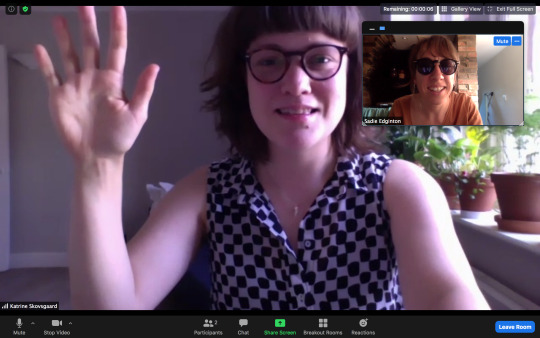
Here we were in break-out groups doing Kat’s one to one activity, thinking about awkward screen moments and working with them, here it was about looking into someone’s face, the intimate thing of facing someone else, that you may not know that well in the screen. We played with reflections in our glasses of each other, the screen, our eyes.
0 notes
Text
‘What do our publics look like now?’
Activity with Sadie Edginton June 16th 2020

‘Here is my lockdown publics diagram developed for a workshop session, which I led with a group of students for the RCA Social Practice Group. I led a session on this again afterwards with a group of art educators and artists for a practice sharing group. Called ‘Writing the Rules for Zoom’ started by Alex Parry it was kick started by Alex’s development of ideas around this topic for a session for the social practice group in May 2020.
The diagram asks questions about different networks, communities and publics that we are communicating with and are in connection with (in the context of the first 3 months of lockdown). I developed mine through a process of creating a few drawings, into this kind of Venn diagram overlapped series of shapes. It was interesting to think about who is ‘the public’ to me, are these people I just don’t know, the ‘unknown’? Or people in various roles, networks or spaces? The process of doing it explored which groups of people I tended to identify as being ‘the public’ or which different publics and communities I was aware of being in contact with, both virtually and physically, at this time.
Putting people into ‘categories’ can of course be problematic, so it was definitely a process of thinking through this. Do publics get reduced or expanded at this time? As the people we are in touch regularly has physically changed a lot, depending where you happen to ‘lockdown’ or which networks or communities you are part of, I wondered how we can analyse and unpick possible and potential new ‘publics’ or communities to interact with, to play with as an audience or to set artwork within, or to communicate with. The delivery drivers, the supermarket workers, the people who walk past your house, these are all potential collaborators, viewers or audiences. Memorable moments in the workshops were: people identifying making regular connections with dogs (not their owners) on the beach, wondering who the people are behind newsletters in email inboxes, having the unnerving ability to ‘select’ online communities and students commenting on the ‘outsourcing’ of care and being able to be in a position of selecting which people or networks they wanted to hear from, speak to, listen to at this time.
It was a process of conceptualising the connections and groups as new communities, to seeing potential works coming out of unexpected daily relationships created by the change in social networks due to the pandemic. To see who or how we communicate in terms of varying distances. One artist commented that it made her think about the varying distances of intimacy that she has now with different people, a shorter distance with a partner, then family members, growing to huge distances, from 1 metre to 2 metre’s, to online distances that stretch across the world.’
More about the session below:
Social Practice Group Session 6, Tuesday 16th June 2020
Notes written: 22/06/2020 by Sadie Edginton
We wanted the last social practice session to be different. After experiencing other practitioners work over the weeks, we wanted the emphasis to be turned onto the students, to create some have room for them to try out their own ideas and to experiment with the format. The group had grown to become a space which felt comfortable, some recognisable faces every week, although there was always a few new people which worked well. Everyone could potentially test out ideas within the safety of the online zoom session format. It seemed to have become important that the group had evolved into a sense of familiarity whilst maintaining the possibility for unexpected things occurring. One student said, that was what she like about this group, that it was one place she could go knowing something surprising might happen. With some students returning often and creating a general sense of being relaxed, the group had created a comfortable sharing space, where people could voice their ideas, share thoughts about where they were, and most seemed open to trying new things out.
We had been playing with this space for the last few months since the beginning of lockdown. This was the sixth session and last (official) session of the school year. We'd had sessions by Louise Shelley, a curator; about group listening and reading processes, Alex Parry led us through a playful workshop stretching the rules for zoom, and Tim tried out his laptop-synthesiser experiment creating collective sounds out of objects in our homes with students now based across the globe overlapping their object orchestras into a magical din.
I had missed a session two weeks before where the group had had an informal conversation about what they'd like to try out. We'd had some interesting feedback too where students had said they felt like this space for sharing and practicing was needed, and it seemed to open-up space for vulnerability (through sharing) and support.
I had planned a vague structure for the last session, I would introduce, do a check-in so that everyone had a chance to speak and do a half hour workshop about mapping the publics and communities we were connecting with now (and how this has changed during lockdown).
There was then time for three students slots; Sally's workshop on confronting the awkwardnesses of online communication, followed by a 5 minute break, then Kats workshop about the taste and other sense. Everything went over time-wise so there was only 10 minutes left for Yuka to play us her experiments with the spatiality of sound.
We started by going around the group using these two questions for a check-in.
'What does 'the public' look like, from where you are now?'
'How are you connecting to a community?'

These questions were borrowed from a recording of a discussion here: http://www.nowandthere.org/blog/2020/4/7/nt-asks-what-does-public-mean-right-now
It was interesting to hear about where the students were based, most in the UK, then China, Japan and Paris. We had seven students and Hannah and I, so altogether it worked well for creating a grid of nine on the gallery view on zoom. As we went around the group I was struck how each student shared with us a detailed picture of how they were in unexpected circumstances and feeling isolated. Some had just travelled to another place, and were stuck living mostly inside and with family, they were not sure about what a local community might look like. One had discovered new communities through volunteering for local mutual aid groups, Hannah mentioned working with existing connections to create networks of in different ways, new connections with animals and birds seeming to be important. Some international students admitted they didn't feel like they had a community, whether they were in London, or back home. One said she felt like there were layers of community, from those close by who were a local support system, then the online groups she was part of, and then her family members who were contactable by phone. Another student said that communities felt ‘chosen’ at the moment; that you could select who you wanted to be in touch with, and it was almost a way of ‘outsourcing care’. Another mentioned that new rituals had emerged in her local village neighbourhood, kicked off by the Thursday clap for carers, leading to local people creating other ways to come together in the street, such as VE day where they set-up tables outside. Another student said it was so long since he had been in Beijing, now that he was back there again, he had to try to find people again who he had known a long time ago.
Next we created 'What do our publics look like now?' diagrams. Attempting to get away from a formal 'pdf' presentation, I sketched out the questions and stages of the diagram drawing onto paper beforehand, and held them up to the screen. I asked everyone to draw a square or circle and inside it to list groups of people, categories of people that they were seeing in real life, in 'physical space'.

I was interested in what different or new groups of people were identified, in the lock-down. For instance I was not staying where I usually live and discovered that I was coming into contact with; next-door neighbours, people who walk past the house, the vet, the nurse at the GP, dog walker friends and dogs who were our dogs friends, delivery drivers, shop-keepers and the public we see on walks. This changed again when I went back to London.
We drew overlapping bubbles and listed those we connected with through 'virtual' connections, then 'phone calls', emails, social media, and letters.
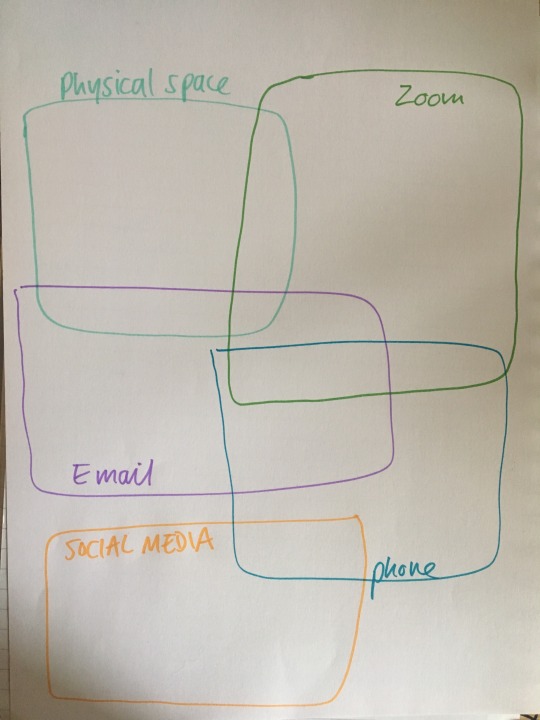
The idea was to then circle in a different colour, those categories of people who you didn't know. Or who you saw as 'the public'. I was intrigued as to if it could be used to locate a new audience/ public for an artwork, project or workshop.

Practice diagram by my mum, Sue Edginton

Holding up my publics diagram to the screen
Reflection: We did the activity a bit too quickly, as it turned out it takes a long time to think through all of this, and I did not have time to get proper feedback afterwards. I showed a few slides about this idea of the physical public becoming much closer, smaller and local, and then the opposite happening with the virtual public where it really expands to include an international community. The publics or groups I was working working with or had contact with still, had really changed too. From working in schools and care homes with lots of people and children face-to-face, this has changed. Now I was just in touch with people via zoom calls or colleagues via the phone, and all the work with children and elders had been put on hold for now. Where were all the people and how were they right now, what were they doing? A lot of people I talked to who work in the community found themselves asking similar questions.
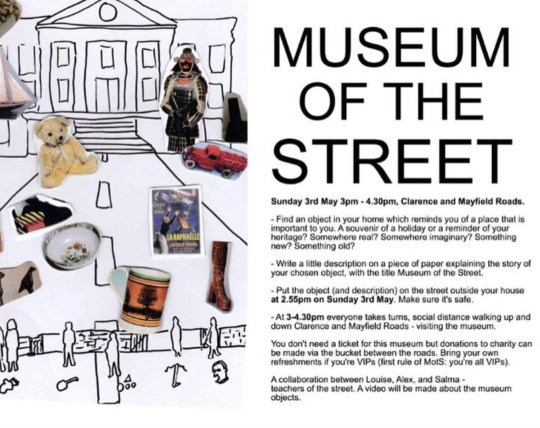
Museum of the Street by Louise Ashcroft and her local neighbourhood, Walthamstow, London, May 2020
1 note
·
View note
Text
‘Make Your Admin Noisy As Hell’
Tim Cape Workshop May 2020
‘Make Your Admin Noisy As Hell’
Tim Cape, a graduate from MA Public Sphere (Contemporary Art Practice) led us through his noisy admin workshop. This could be translated into ‘co-opting your laptop into an lo-fi object sound synthesiser’. By downloading a programme (sound plant) that enabled us to record sounds from objects and insert them into our keyboard function, we could explore recording and playing with sounds from objects around our screens, our rooms and our homes, ending with the group generating an experimental collective noise recording.

Workshop introduction:
Tim is a Contemporary Art Practice graduate. He’s a composer and artist who works in performance, music and film. His practice is focused on performative pieces on the themes of work, the body and the economy.
Tim’s workshop, 'Make Your Admin Noisy As Hell’, is a response to contemporary work realities. The workshop will take as a starting point the default position for a lot of today’s work: sitting at a computer or laptop, getting through to-do lists, writing emails.
To take part and create your own Noisy Admin Machine during the workshop, please download and install soundplant onto your laptop before the session - here’s the link. https://soundplant.org/. Tim will provide you with instructions about how to use the app during the workshop.
There will be a follow-up discussion about the workshop later on today You are welcome to join this too, but it is not obligatory!
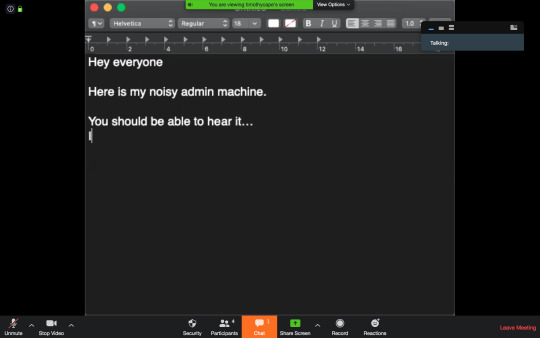
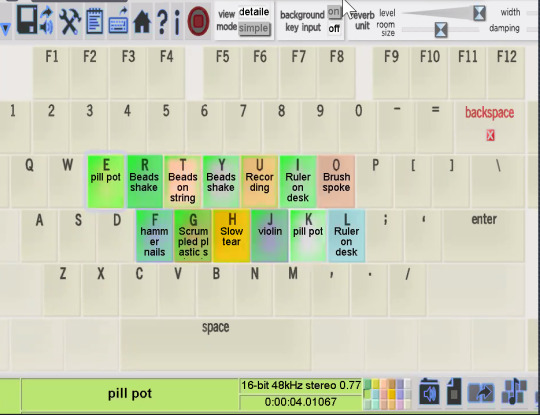

0 notes
Text
Writing the rules for zoom?
Writing the rules for zoom? Navigating socially engaged art practice under lockdown
Workshop by Alex Parry Tuesday April 28th 2020
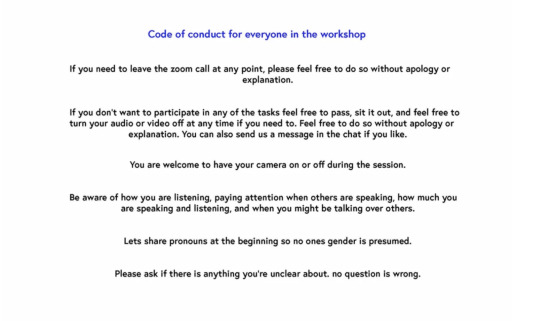
Code of Conduct from Alex’s workshop
We asked Alex Parry, a fellow Public Sphere graduate (and a previous attendee at the Social Practice group in 2018) to run a workshop around her ideas about working with socially-engaged practice. As the pandemic hit, Alex adapted the workshop to the recent circumstance that many teachers, facilitators, artists and educators were adapting to working on - zoom. A programme that many of us hadn’t heard of before this year.

Alex Parry:
With many people at home all day Zoom has become a public sphere of choice with work, workshops, social gatherings and public events all taking place here. As a tutor using Zoom to teach and as a socially engaged artist I am interested in how this public space is being navigated and how Zoom is shaping conversations. The workshop will in part be exploratory and in part practical through testing out some ways to help redress how communication happens here. Here are some articles to look through in advance, but there is no pressure to do so. Notes on Zoom The Art, Pride and Prejudice of Virtual Conversations April 5th 2020, Arts of the Working Class - An article exploring different peoples experiences on zoom.
MPs expected to approve plans for ‘virtual parliament' Rajeev Syal, April 20th 2020, The Guardian
Boris Groys Curating in the Post-Internet Age - I found this useful for thinking about experiences and differences of experiencing art and life through the internet and IRL.
Read Sadie Edginton’s blog about the workshop here!

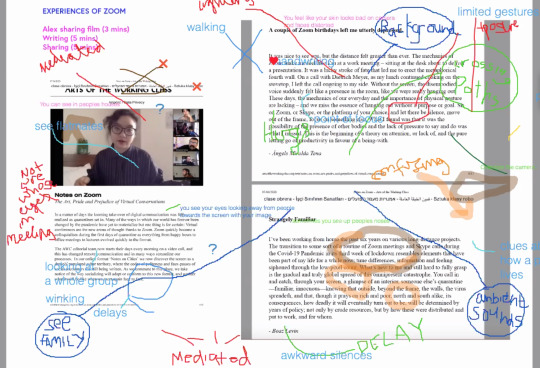
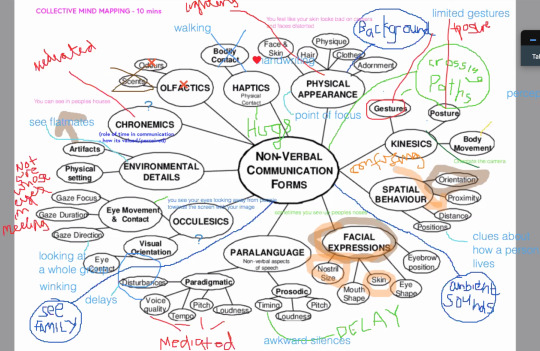



0 notes
Photo

SGP 2020 Session 2: with Curator Louise Shelley
April 21st 2020
Curator Louise Shelley created a brilliant session for us in April 2020, our first session after lockdown started. A time when zoom was new to us and everyone was trying to get to grips with this new way of working and connecting to others, and the sun was out a lot!
Louise sent me an intro quote which I really loved so I’ll post it here:
“What if, instead of providing a resolution, a direct answer, or a definite interpretation, a reading helped us to navigate the complexity of existence – attending to both its actual and virtual moments – its different positions, relationships and layers that also constitute us? Every reading exposes possibilities, reveals blockages, and shifts perspectives. Beyond the principles of non-contradiction and identity, readings design a space where multiple articulations of situations and events coexist without the imposition of a single meaning or direction.” -Denise Ferreira da Silva & Valentina Desideri, “Poethical Readings” Drawing from each other's practices Denise Ferreira da Silva and Valentina Desideri come together for experimental readings. They experiment with 'reading tools' inspired by well-known and newly-designed practices – such as the Tarots, Political Therapy, Palmistry, Fake Therapy as well as Reiki, Astrology and Philosophy. Relying on the kind of knowing that Walter Benjamin calls mimetic (intuitive) faculty and Carl G Jung associative thinking, these tools assemble a reading or an image. Reading as imaging, in their practice, consists in an assembling that exposes and navigates the complex context constituting the situation, event or problem that concerns a person or collective at a given moment and place. As such, it aims at expanding the horizon of interpretation, that is, to open up possibilities and unsettle realities.
Before the session Louise shared with us two texts to read:
- Pauline Oliver’s Sonic Meditations (famous and much used recently in listening and meditative collective sound work
- Ground Provisions by Tonika Sealy Thompson and Stefano Harney (an interesting text about a great project which is centred on ideas of reading together and reading as refuge).
Louise Shelley’s session started with telling us what was important to her:
The work that I'm interested in really centres collaborative practices and the politics that are inherent in that, so that means the sort of differences that we might all bring to the collaboration.
How can we do something together that still hold space for all of those differences in those polarities?
Thinking about how collective work can counter competitive landscapes that are dominant in our lives, and particularly in the cultural sector. And also looking specifically at what histories or ways of working collectively have come before us how we can draw from them and how we can sort of fold them into our own lived experiences or our own issues at stake, like now, for instance.
Collected formats can also be imaginative and playful and experimental
The exercises are taken from different forms of pedagogy, critical pegagogy and lots of different histories or ways of trying to have an embodied way of sharing and relating and thinking about power dynamics
Group check in - where everyone said their name, how they felt at the moment and what they could see in front of them. It was a good way to connect to the physical space and find out where in the world all the students were.
Counting game - as a group we played the game that focuses in on listening to the others in the group. We had to count from 1 to the number of the group - 17, one at a time without people saying the same number together, then you have to start again. It was tough but we got there! It really reinforced the idea of collectively straining to read the group, to leave gaps for others to speak and kind of anticipate when there is space.
Next Louise introduced her curating practice and a few of her recent projects, ideas and contextual references and approaches. https://curatorlab.se/louise-shelley
The Creative Commons

Learning and Unlearning
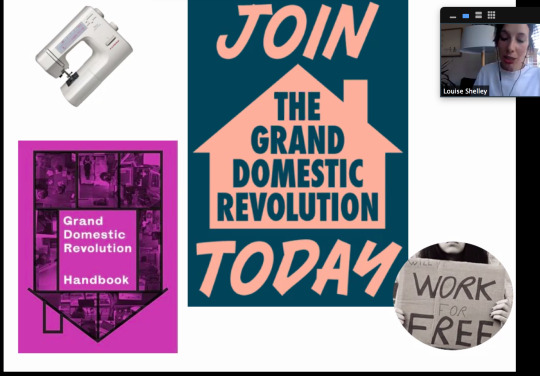
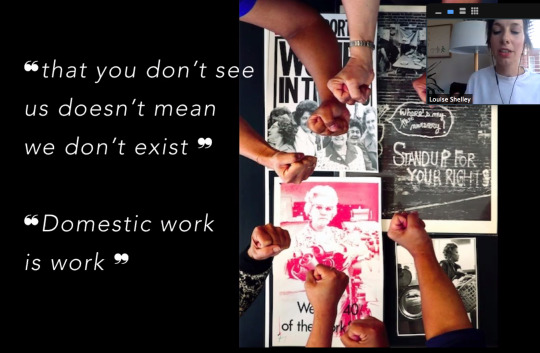
Working with Domestic Workers of the world.
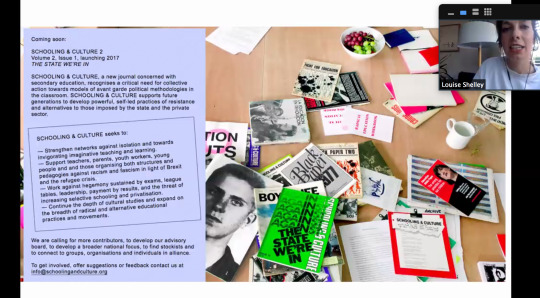
Schooling and Culture ‘The State we’re in’

We did a listening exercise - from Pauline Oliveros
Louise: I wanted to do some exercises that draw on some of those ideas and also quite interested in ways to collaborate or work together that think about who has the loudest voice in the room, or who always steps up to talk and trying to create things that reflect on that. I'm quite interested in forms or exercises that don't prioritise language that maybe are about expressing or thinking through our bodies and as a way to, I guess, think about care or emotion and process knowledge or values that aren't of sort of articulated.
Practices that embody sort of slowness or contemplation or listening when we've been sort of forced into this position, it's not sort of in resistance to productive modes of capitalism that have been shaping us for decades. It's meant to be a habitual practice, a bit like the check in that the more you do it, the more you would be able to sort of work through blockages or sort of reveal things as a group.
Louise showed us this pink screen and read to us from Pauline Oliveros Meditations:

Try it yourself!
Intro: Sonic meditations are intended for group work over a long period of time with regular meetings, no special skills and necessary. Any persons who are willing to commit themselves can participate, the ensemble, to whom these meditations dedicated has found that nonverbal meetings intensify the results of these meditations and help provide an atmosphere which is conducive to such activity. With continuous work some of the following becomes possible with Sonic meditations heightened states of awareness or expanded consciousness changes in physiology and psychology from known and unknown tensions to relaxations which gradually become permanent these changes may represent a tuning of mind and body. The group may develop positive energy which can influence each other who are less experienced members of the group may achieve greater awareness and sensitivity to each other.
Sonic meditation 25 ‘your name, the signature meditation’
Considering the amount of time. Okay, so close your eyes.
Think about your name. And visualize writing it as slowly as possible. Visualize your name as you sign it mentally
Visualize your name with your eyes closed. And now with your eyes open. Close your eyes. Visualize your name in different kinds of writing. In script. Imprint. Very the sizes. From microscopic to gigantic
Vary the colors and very the backgrounds. Very the dimensions. Vary the spacing. Visualize your name backwards. Forwards. Upside down. And inside out. Visualize your name written with your left hand. Unwritten with your right hand.
Visualize your name on the horizon. Until it disappears. Now I want you to try and visualize someone else's name in the group.
Once you've picked that name. Visualize writing as slowly as possible.
Visualize the name with your eyes closed and now visualize their name with your eyes open. Close your eyes. Visualize their name and different kinds of writing. And script. In print. Very the sizes of their name from microscopic to gigantic
Vary the colors and the backgrounds. Vary the dimensions.
Visualize writing the name backwards. And forwards. Upside down. And inside out. Visualize writing their name with your right hand. And with your left hand. Visualize that name on the horizon.until it disappears.
Louise Shelley: Okay, open your eyes.
-----------
We did some collective group reading of texts with everyone taking turn to read out loud. This became really powerful, and it was important to slow down and do it for quite a long time I think. It also related strongly to the text Louise gave us in en email beforehand (Ground Provisions by Tonika Sealy Thompson and Stefano Harney)
Fred Moten’s The Undercommons
Seeds for change resources
Pablo Martinez
Casco - what we mean when we say commons
Nataša Petrešin-Bachelez For Slow Institutions
Barby Asante - Rights to the city
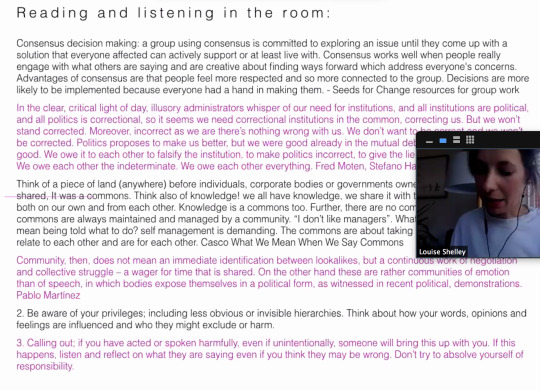


Louise asked us all to think about What is at Stake? In our own ways of working.
What’s is at stake for each of the students, in working collaboratively, the motivations?
She said ‘often I ask these questions that should answered with a few words:
-what can you offer to a collaborative project?
-what would you like to gain from a collaborative project?
-and a word of encouragement?
0 notes
Photo
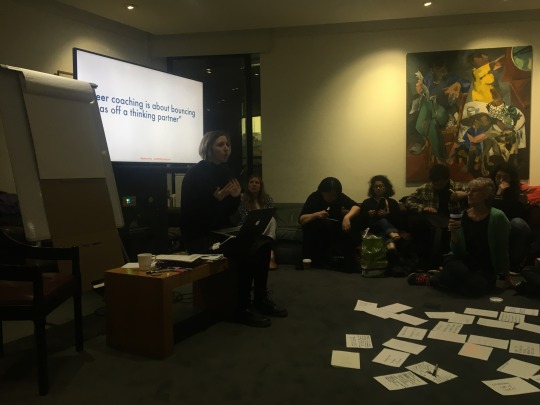
SGP Session 1 February 18th 2020: Beki Gowing Peer-coaching workshop
As we started the social practice group again, in the spring of 2020 we wanted to try out a different structure. This would include dividing sessions into two parts, and inviting a guest practitioner or artist to lead a workshop that students could experience and discuss afterwards. The other half would be based around a peer-mentoring structure so that students could learn skills in how to support each other with a framework, to connect back to their own practices and allow them to create links with other students concepts and projects, perhaps leading to future collaborations. Its also an interesting and more supportive response to the art school ‘crit’.
We invited Beki Gowing to do an hour-long session in peer-mentoring which we tried out in the seminar room.
Beforehand Sadie led a practice-sharing exercise, a useful tool in establishing the interests, knowledge (or lack-of), practices and questions in the room.
Beki’s peer coaching method was to work in groups of 3 - triads. Each person takes on a role.
1) Coach
2) Coachee
3) Observer
The time was divided into 15 minute chunks. Thus each coachee has 10 minutes to be ‘coached’ and the observer has 5 minutes to give feedback to the coach, about how they did as a coach and any improvements they could make. So all in all it took 45 minutes to give everyone a turn to be coached.
The idea is that unlike tutorials where the tutor (over) speaks to give specific ‘advice’ and possibly references to the student, the coaching technique works to get the coach to ask open questions to the coachee. This enables the coachee to problem-solve themselves and develop ways to workout what is going on, identify what they need to do and work out what to do next.
We focussed on art our practice or current projects, so here the coach starts with an open question about art practice, such as:
- Tell me about... (insert topics)..? What would you like to discuss? What would you like to get out of our conversation? What do you want to think through?
And then problem solving questions like...
- What have you tried already? How do you feel about that? What could you do differently? What else could do? What action would you like to take?
It helps to aim to create some kind of plan of action at the end, that you discuss that can be decided on before the session is ended, such as:
What action would you like to take? How can you achieve that? What support do you need to do that? How or where can you find out about the support? What would you do first? Who would you ask to help you? What are you going to do this week? What equipment do you need?
It can end with something concrete and attainable: Write down your plan. Write down 10 things you will do next.
It was difficult to hold back and to not give people direct tips, ideas, help or references. To help with this, whenever an idea came into the coach’s head, we decided we would note them down on paper and give to the coachee afterwards.
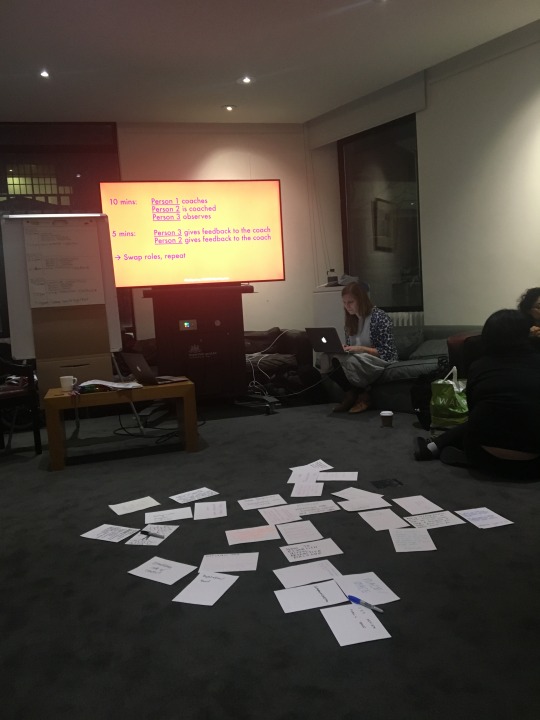
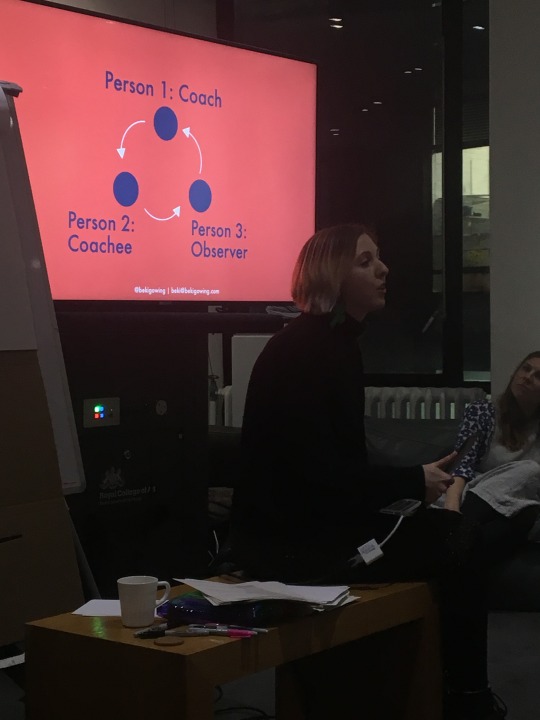
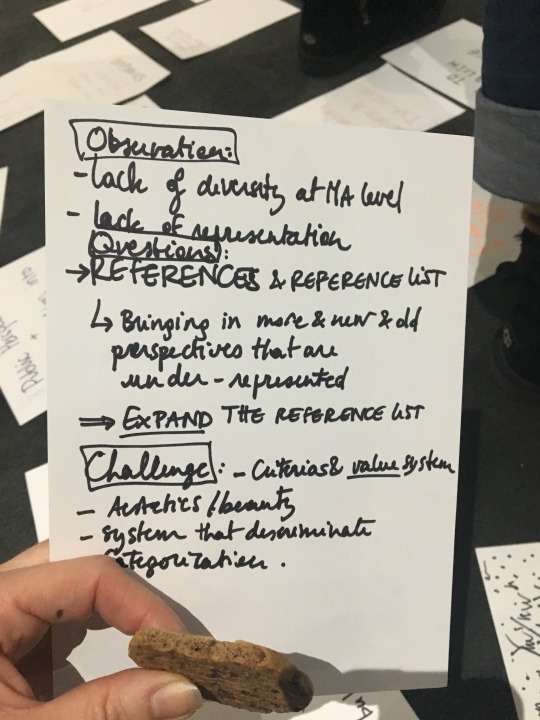
0 notes